Gardens offer so much positivity for many people, from a rewarding hobby, to supplying necessary foods for survival. So, the last thing a gardener wants to do, after their hard work and money spent creating a bountiful garden, is to lose the fruits of their labor to pests.
Uninvited predators, such as rodents or those annoying grasshoppers, can destroy a garden, sometimes overnight. Unfortunately, pesticides are not only expensive, but who wants to work with or ingest them? Not me. And, I don’t think I’m alone in that thought.
So, let’s take a look at some effective, yet natural ways to help eliminate unwanted pests acting as though they are entitled to your crops.
Related: 4 Ways to Keep Monsanto Out Of Your Backyard
Rodents
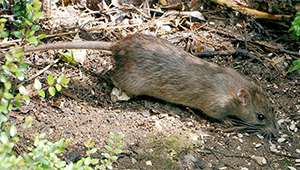 Rodents come in all shapes and sizes, including rats, squirrels, and chipmunks. And they all can be a problem for gardens.
Rodents come in all shapes and sizes, including rats, squirrels, and chipmunks. And they all can be a problem for gardens.
I don’t know about you, but we see several squirrels and chipmunks (and more) in our area on any given day. I’m sure rats are also around at some point.
They eat a huge variety of crops, leave their droppings behind, and can spread disease. I won’t even get into how quickly they can multiply. So, if you see one, just know that there are many others around, or could be in a few weeks!
Here are some options that are safe for your plants, children, and pets:
#1. Mulch
It might look nice and act as a weed deterrent, but it also tends to draw rodents in, looking for comfortable spots to nest. However, if you have your heart set on having mulch, opt for a wood chip variety, which will not be as comfortable.
#2. Your Own Predator
Cats are notorious rodent hunters, especially mice. Cats like to roam the area enough to scare off most of the rodents. However, make sure to keep the cat fed, with plenty of water and provide shelter.
#3. Mint
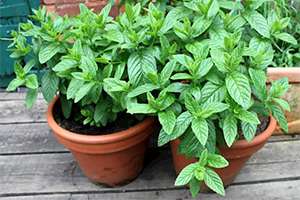 Rodents don’t like the smell of mint. Plant a few pots of it around the garden and it will do all the work for you.
Rodents don’t like the smell of mint. Plant a few pots of it around the garden and it will do all the work for you.
You could also scatter dried mint around the garden. However, that could get costly, as it would have to be reapplied after hard rains, or the scent wears off.
Another option is to soak cotton balls with peppermint oil and place them around the garden.
#4. Other Herbs
There are other herbs you could plant, such as thyme, basil, echinacea, or garlic. If you surround your garden with these herbs, rodents will think that’s all you have and probably leave, because they don’t like them.
#5. Pet Food
Rodents love pet food. If they can’t smell it or get to it, it won’t attract them.
If you feed your pets outside or store the food outdoors, just put out enough for one meal at feeding time, and store the rest in an airtight container.
#6. Fences
Some rodents dig and get under fences. However, if you secure it by creating an underground barrier (such as a grid hardware cloth), at least 6” deep from the bottom of the fence, it will make it difficult for burrowing rodents to get through.
#7. Onions
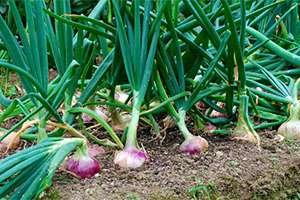 Rodents do not like the pungent smell of onions. Simply put an onion or two where you think you might have a rodent infestation, and it should drive them away.
Rodents do not like the pungent smell of onions. Simply put an onion or two where you think you might have a rodent infestation, and it should drive them away.
The onions will rot though, so replace them every few days.
You could also grow onions or leeks, which also add more fresh produce for your harvest.
Word of caution: keep onions away from your pets, as they are poisonous to them!
Related: Why Put Onions in Your Socks Before Sleeping
#8. Instant Potatoes
Sprinkling instant potatoes around the garden will help get rid of mice. It might be too harsh for some people to consider this option, but it can be quite effective.
The instant potatoes expand in their stomachs and are hard to digest. They will most likely go off to find water and die.
Grasshoppers
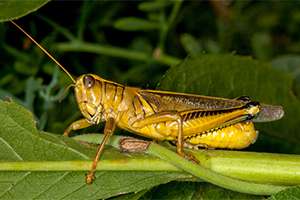 But, what about those pesky grasshoppers?
But, what about those pesky grasshoppers?
It’s not just that they are annoying little creatures when you walk through a group of them, but grasshoppers can destroy a good crop.
Here are a few ways to get rid of them, as well as of other small pest:
#1. Garlic Spray
Small garden pests, such as grasshoppers, do not like the smell of garlic. Make a spray by boiling 2 bulbs (not cloves) in about 10 cups of water, for no more than 5 minutes. Let the mix sit through the night.
Put it in a spray bottle, then spray the leaves of plants they are bothering. Re-apply every few days.
Related: Why You Should Put Garlic in Your Ear
#2. Flour Dusting
Flour will gum up their mouths, creating the need to go elsewhere to find water. Simply sprinkle a light dusting of all-purpose flour on the leaves of plants that are being bothered. Re-apply as needed.
#3. Other Predators
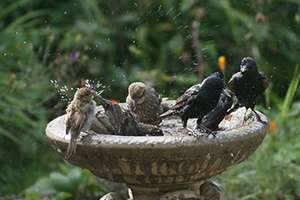 Introduce grasshopper predators to the garden, such as birds. They love grasshoppers and will help keep them away. Birdbaths and feeders are a great way to attract birds.
Introduce grasshopper predators to the garden, such as birds. They love grasshoppers and will help keep them away. Birdbaths and feeders are a great way to attract birds.
Just keep in mind that birds also love some of our crops, like berries. So, this won’t work for all gardens.
#4. Grass Trap
Select an area nearby that you can let the grass grow. Grasshoppers love long grass and will flock to it, making it easier to keep them away from crops, or easier to trap.
So, if you have worked at creating a garden, there are many options for protecting it. You could try one of the above, or a combination of any of them.
You may also like:
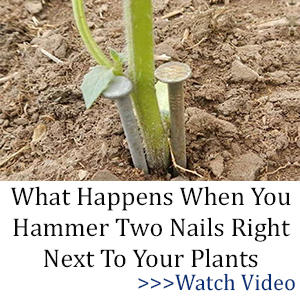 How to Properly Harvest Seeds and Get a Sustainable Food Source Year Round
How to Properly Harvest Seeds and Get a Sustainable Food Source Year Round
The 10 Medicinal Seeds You Should Plant for a Complete Backyard Pharmacy (Video)
200 Pounds of Food With this Plant You Can Harvest in Winter

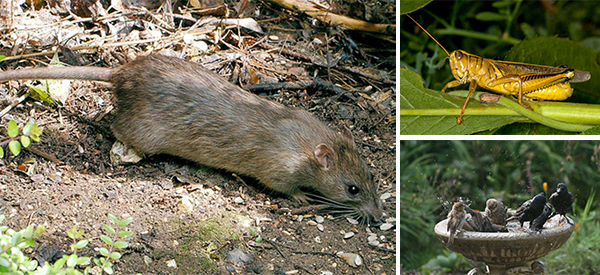













What about deer? They have just eaten flat my 750″ of Dixie Lee Peas.
I would suggest putting up the electric netting fence. Just make sure that you leave it far enough away from your plants so they can’t lean their heads over and get it. Or find a way to put up a tall fence around it if you can. Those are my only ideas that I can com up with.
I hear deer will jump fences but if they don’t see a safe place to land on the other side, they won’t jump it. Line the inside to about six feet with brush or something. I’m not sure how far in you need to go to discourage them, maybe not six feet.
IDOLATRY IS DEAD AND GREED, NOT TITHING 10% IS STEALING.
I read somewhere to use a smelly soap like Irish Spring in socks hung around the plants.. you can shave it into smaller pieces and spread it around… worth a try.
You can also buy coyote urine which is supposed to chase deer away. I don’t know how long it lasts. I suppose it depends upon how much rain your area has. That’s something that is of little concern here in SoCal. I think the last measurable rain we had was in early May and it was .001 of an inch. I don’t know how they measure that small an amount. I think they just made that up because the concrete was wet and they had to report something.
Sprinkle Human Hair around the garden — seriously this works
I don’t know, JG. I asked on the local Nearby Neighbors website if a 6ft fence would protect a vegetable patch in my backyard and they all laughed their butts off. My son bought us this sonic device to keep them away and they will lie down in the backyard and stay there the whole afternoon. I’ going to call the county extension agent to see if they have any ideas, but don’t expect much help. When I called about getting rid of the gophers, they suggested peaceful co-existence. Will pass on any wisdom they do share. Meanwhile, just sign me Don’t like Raisinettes anymore.
A 5 foot fence will work if there are raised features (e.g., uneven logs, raised garden beds) located near (2 or 3 feet) the inside fence perimeter. The deer will not jump it if the ground they would land on looks uneven and dangerous. Also, deer will not jump a fence they cannot see through. So some visual blocker like vertical vinyl slats (for chain link fencing), a tarp (which, unfortunately, will decay), or wood slats or boards would work.
Deterring gophers requires an underground buried fence, which can be a lot of work. Havahart traps might work, but what you can do with the animal depends on state trapping laws.
The deer got into my garden two nights in a row. They ate my beans, peas, and lettuce. A friend told me to put a radio in the garden, so I gave it a try. I haven’t had any more visits from deer, and I can enjoy music in my garden while I’m working! (Cut off the corner of a heavy duty zip-seal bag, thread the cord through the hole, seal off the hole with packaging tape, seal the bag and hang in the garden. Be sure to tune the radio to a 24-hour station.)
Put up a sign NO DEER ALLOWED or DEER FREE ZONE
My son went hunting in eastern WA with some buddies. No sign of deer all weekend. Spent the night here on way back to Seattle. Next AM got up there were three in our backyard, one an 8-point buck. Signs are the one thing I haven’t tried. Maybe…
ROFLMAO – I expect the deer to read and obey just as well as criminals read in Gun Free Zones. ??
Sabel: Well, that is the thing about deer, a shy woodlands critter. they’re only shy during hunting season. niio
I expect the deer to read and obey those signs as much the criminals do the “Gun Free Zone” signs..??
Put up some signs DEER FREE ZONE or NO DEER ALLOWED
jim: post it on an old freezer in the yard niio
niio
Human urine keeps deer away. A fence either needs to be 8′ tall or two lower fences 3′ apart. The two lower fences can be electric fence but the inner one should be visible. I have lots of deer close to my garden but never in it. My present fence is just a welded wire fence 4′ high with a white rope above that at 6′. Seems to work.
Thanks, Pa. We tried human urine on the gophers and nothing happened. Then a neighbor told me her grandma used ammonia so poured that down the holes and it worked. Will ask husband to get out the mayo jar and see if it works on the deer.
Great help for us poor suckers who struggle with all kinds of problems in the garden. To get rid of aphids and other small critters hanging on our plants, add a little dish washing detergent ( not anti-bacterial) in a spray bottle filled with water and spray the whole plant.It won’t hurt edible crops or flowers, either.
I have found a way to control squirrels. Many may not like this but it has taken care of and continues to eliminate squirrels in my garden and yard. I place a piece of RAMIK in the yard where I see squirrels. They pick it and take it where ever and die. RAMIK is for rodent control and works on squirrels. I have seen no other animals touch it. Anytime the squirrels take a piece I replace it. It takes awhile to clear the area of squirrels.
A couple of problems with using poison for rodent control: if a poisoned critter is eaten by another animal, it could end up killing them as well. Possums, raccoons, and birds of prey are all carrion eaters, as are dogs and cats – probably not animals you want to accidentally kill. The other problem is the stench of a decaying carcass, particularly if it’s a squirrel that expires up in a tree where you can’t reach it. You’ll be smelling dead meat for a couple of weeks until it dries out.
I recommend Nolo grasshopper bait. It is a natural pesticide that works by interfering with the grasshopper’s digestive system. The bait is made from flaky wheat bran coated with Nosema locustae spores. The best part is that once the grasshopper dies, other grasshoppers will come along and eat their dead brethren (yes, they’re cannibals) and will also die. The nolo bacteria will even persist over multiple growing seasons. I haven’t had to use it for the last two years and I almost never see ‘hoppers in my garden.
For squirrel control, I highly recommend the Ouell squirrel trap. It is a sturdy and well-constructed piece of gear that kills critters instantly and humanely. I bought mine through Amazon.
Garlic and onions will not save your other crops, and you will lose you garlic and onions, too. I speak from experience. The underground dwelling creatures around my place love the garlic and onions along with the potatoes. I swear they must be gourmets. When you plant 250 cloves of garlic, and less than half are there in the spring, there was not even a sign in the ground that they had been planted, and then, as the survivors are growing up in the spring and summer, and you watch the plants disappear and at harvest many of the bulbs are partially eaten, you know that they are no deterrent. Same with the onions. They also say hardware cloth, schmarware cloth. Took out my entire raised bed of asparagus that had hardware cloth tacked on the bottom. So do not look to these as a cure all. You will be disappointed.
I had much the same problem, plus elm trees that wanted to grow in my nice rich soil, and raccoons love my tomatoes. I built an 8 foot chicken wire fence and the rabbits and deer stayed out, but the raccoons had a jungle gym. I laid 12-foot 2×4 across and put rabbit fence on top. Kept them out until they burrowed under the chicken wire.
I finally got mad and decided I was going to put in a cement wall. Thanks to Facebook market place I soon had 20 bags of free Quickcrete that had gotten damp. Another 30 that I bough and I have a wall 3 feet down, 6 to 8 inches wide, all around my garden.
I have enjoyed my lettuce, radishes and tomatoes for the last two summers and only had insect pests. The old trick my grandmother taught me of 2 tablespoons of Dawn dish soap, 1/4 cup cider vinegar and water in a spray bottle still works. Mist it on the plants and it keeps most bugs away. Turn the spray bottle to a stream and it makes a wasp killer too.
Hope this helps
Similar Spray mixture using dish soap, water, vinegar damaged my tender herb plants. Lost lots of foliage as it turned brown. I probably sprayed a bit too much on!
Two years in a row now, I have been fighting off grasshoppers – several varieties at a time. Last year, that included the “Jumbos” or Eastern Lubbers. They ate the onions, the garlic, the cucumbers and gourds, went through 3 dozen potato plants in 2 days, Even ate the gladiolas right down to the dirt. I have one pumpkin plNt that was in a different garden, 120′ away from the other veggies, that survived. But they won’t eat the weeds. So, they have no redeeming value to me.
Garlic spray, Diatomaceous Earth, Cyonara Insecticide – tried all 3, still have the grasshoppers. Have decided on the “Nuclear Option,” hoping it will work…we bought 9 Guinea keets. They are about 5 weeks old, as soon as the automatic coop door arrives and gets installed, we will put them into their new home, train them to come back in at night and let them do their thing.
I really hope they like to eat LOTS of evil grasshoppers.
Good luck, Sabel with the Guinea fowl. Looked them up and the only downside listed was sometimes they are noisy and they drop their eggs anyplace they want. Otherwise sound okay. If you get a chance, please post a follow up in a while. Your solution is creative, but I always worry about unintended consequences like the cane toads Down Under. Hope it works out.
In the past I’ve had trouble with Cardinals punching holes in nearly ripe tomatoes to drink tomato juice, and purple finches nipping off and eating the tips of jalapenos. This winter i removed an old nonproductive plum tree from the garden and it seems to have solved the problem, the birds are elsewhere. The crows here also have gourmet habits, they steal my pecans and hang out at the back of property shelling and eating pecans and crawdads.
A physical barrier like bird mesh would help with hoppers, but the big hungry ones will eat the mesh then have cucumber for dessert. A better choice than hardware cloth for a barrier underneath a raised garden is expanded metal, they make it with 1/4″ diamond mesh for stucco, it’s carbon steel and heavy enough the dang gopher can’t chomp through it. Costoso, a 4×8 sheet is close to 100.00.
Longstanding garden myth is that there are plants that repel pests to a useful degree, there are not.
My favorite predator of grasshoppers is the golden orb spider, I usually have several in the garden, their webs are several feet across, they catch a big grasshopper, wrap it up in silk, then inject it with enzymes that liquify the critter’s insides so they can suck ’em dry. One big grasshopper is enough to start development of an egg case, the spider doubles in girth then delivers a brown cocoon full of fertilized eggs she hangs from a twig not far from her nest. Then it’s back to work catching another hopper. Problem is, they only average about one a week. Very cool animal the golden orb spider.
Gee, after reading all of these garden horror stories, I don’t feel “picked” upon anymore!
We would put the squirrels and rabbits in the freezer, they don’t eat any of the garden plants after that. When there were enough to make a meal we took them all out of the freezer and had a good meal on them. They no longer have predators to control their numbers so we did.
Coarse mulch deters rodents and insect pests.
Cats carry as many diseases are the rodents they feed on. Use bait, not cats.
Best bet on deterrent plants, anything in the rhododendron family is toxic, and the animals know it. We have other things like mescal bean brush. Sulfur pellets flushed into burrows also works. Borax, with caution, is good (one scant teaspoon in a gallon of water. Even that much can kill plants).
This year, thanks to quail and thrashers, bugs aren’t a problem. The problem is, quail scratch and eat seedlings, while thrashers will dig out seeds.
Problem: No grass. It’s too dry for most types, and the rest is seasonal. niio
We have found hornworms on our tomatoes and potatoes this week! Evil things! Using diatomaceous earth and giving the ones we find to the chickens.
We’ve been using various Bt sprays (bacillus thurengiensis) for years with excellent results. This is a bacterium that can be used up to the day of harvest and works by messing up the caterpillars digestive tract. It has no known effect on humans or beneficial insects. We get ours through Peaceful Valley Garden Supply. They also sell something called Monterey Spray which works the same way. The active ingredient is Spinosad. One spray as soon as you see your first hornworms and maybe a follow-up spray mid season is all you need. Also works great on codling moth caterpillars for those of you with apple trees.
Kurm: Spinosad works on all fruit trees. It can get well into the 100s here (Arizona) and it’s supposed to help keep the tree cool, and deters birds as well as bugs. I heard Kali-fornia is being invaded by needle ants from Asia. Folk there use them to protect fruit trees by moving nests–do not touch the nest. They tie ropes from one tree to the next and add dampened fish meal to the rope. Ants will follow that to a new tree and a feast on bugs. Commercial orchards put up signs warning would-be thieves of the ants. the ants are carnivorous and feed on any bug they catch, even other ants. Some good out of even wreckage. niio
Thanks for the advice! I have hubby shopping for BT now!
Jennifer: I had them last year and they ate the chili peppers to nubs. None this year, the scorpions and lizards are after them.
Where can I score some lizards and scorpions in Ohio? ; )
Jenn: Go to a Hispanic ‘hood and look. when in PA, i was stung by more scorpions than all the years in Arizona. We lived in a Dominican ‘hood. this year, quail invasion. Bighorn fire took out 114,000+ acres, stopping only when it hit cattle range. Quail from the wilderness area moved down here and now, chicken wire cages are a must. No, by hunting season, they’ll all disappear. It’s like javelina pigs and deer, they’re only shy during hunting season. Lizards, sorry, you’re on your own. niio
It’s like javelina pigs and deer, they’re only shy during hunting season. Lizards, sorry, you’re on your own. niio
I bought a manican on Ebay. She works all day and all night. She has never complained or has asked for a raise.
Any suggestions on how to get rid of stink bugs? They have infested my tomato plants the past two years and I can’t seem to get rid of them. I pick them off by hand but I can’t seem to be quick enough before they destroy all of my crop. thansk
Stefuhne, see comment below regarding your stinkbug problem.
Stefune: this site recommends kaolin clay.
https://www.gardeningknowhow.com/plant-problems/pests/insects/stink-bug-control.htm
niio
Try Safer EndAll Insect Killer. Active ingredients are neem, pyrethrin, and insecticidal soap, so it’s organic and does not persist in the environment. Also it is OMRI listed.
As a follow-up…
Our Guinea Fowl are doing well. They are growing, eating, growing some more. They all know where and when dinner is served so they all show up at their house in the evening, right before sunset. Yes, they are loquacious but since their house is down near the garden, well away from the current house, it doesn’t bother us. And if we, eventually, add some chickens to the mix, they are the early warning system to let the chickens know it is time to run inside and away from predators. 4 of them have names, the other 5 haven’t really shown enough in the way of distinctive personalities yet but I expect that yo happen soon enough. I just need to figure out how to catch each one and keep them calm and contained long enough to get colored leg bands on them so we can tell those last 5 apart since they are all “Pearls” without any real distinguishing marks. 2 of the Pearls do have distinguishing differences and have been named accordingly.
As birds go, they are not the sharpest tools in the shed but they seem to learn eventually. Meanwhile, the season should be winding down in a month or so and the temperatures should be getting a little milder, so I am hoping to be able to plant a few things for a fall harvest. I noticed 1 radish seedling had popped up the other day. Hopefully, the ‘hoppers ignore it.
And that one pumpkin I thought I had turned out to be a “volunteer” (aka, a weed) called a “Devil’s Claw.”
Red – What do you know about them? It is sticky all over, stems, leaves and fruit, and has a pretty white flower that almost looks like an orchid blossom but the blooms are at the end of stems in bunches, very popular with the bees. White with yellow centers and red streaks and spots radiating outward toward the petals. The fruit is green, oblong with a distinct curl at the outer end. When they finish ripening, they turn hard and black and split open to expose seeds. According to a local, they catch your ankles as you walk or run by and trip the kids. They are quite prolific out here in West Texas/Panhandle.
We also have Buffalo Gourds that grow wild here. From what I have been able to find online, the seeds can be roasted and eaten like pumpkin seeds but the pulp isn’t very edible. The gourds are round, baseball size, greenish-yellow with faint lengthwise stripes and the leaves are arrowhead shaped, growing on vines 6-8 feet long along the ground.
Is this it? It has a lot of uses. But, it doesn’t grow in my area. It likes sandy soil, and not our adobe-caliche. niio
niio
https://www.foragingtexas.com/2012/07/devils-claw.html
https://www.desertusa.com/flowers/devil-claw.html
https://www.shutterstock.com/search/devil+claw+plant
Buffalo gourd seeds are good to eat, but the flesh isn’t. One major thing it is good for, squash stem borers and other pests prefer it to all other plants in the family. As I understand, it’s too distantly related to cross with domesticated squash, so it’s safe to save garden seeds. Just don’t mind the stink
Yes, the first two links are correct. Apparently, I have the perennial variety, the p. altheaefolia. Foragingtexas’ distribution map by county is not even close to being inclusive since we are up at the southern edge of the Panhandle and it only shows areas of Texas down near Mexico and one county that looks to be south of the D-FW Metroplex. We are 150-200 miles NW of there and we have lots of them growing around here.
I haven’t noticed any smell from the Buffalo Gourd but then, I haven’t purposely gone sniffing around it. The Devil’s Claw is fairly fragrant, though. I will have to start harvesting the seed pods of the Devil’s Claw. I noticed the other day that one of them had turned black and split. And some more of the Buffalo Gourds were ripening. We had a pretty serious thunderstorm the other day, lots of rain and gale force winds, so the Devil’s Claw in the garden took quite a beating.
The good news is that I actually had a radish seedling sprout up in the garden at the beginning of this week but I couldn’t find it yesterday so the grasshoppers might have gotten it. I’ll have to check again today.
Thank you for the info and the links on the B Gourd and D’s Claw.
Next year, if the Guinea Fowl do their job, I am considering raised beds for the garden. Something has to work eventually.